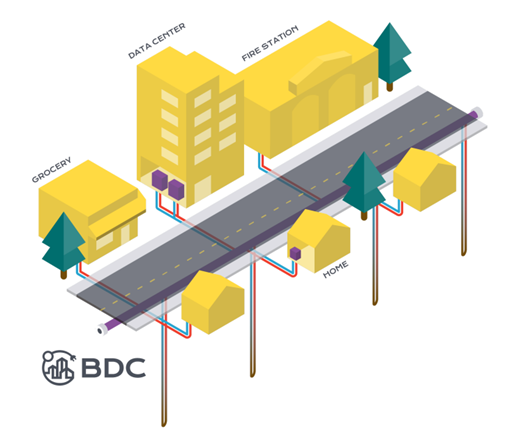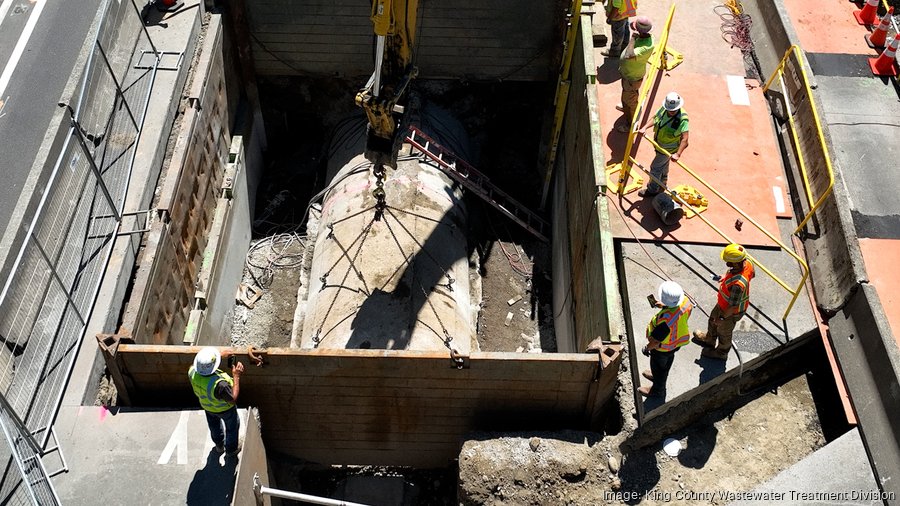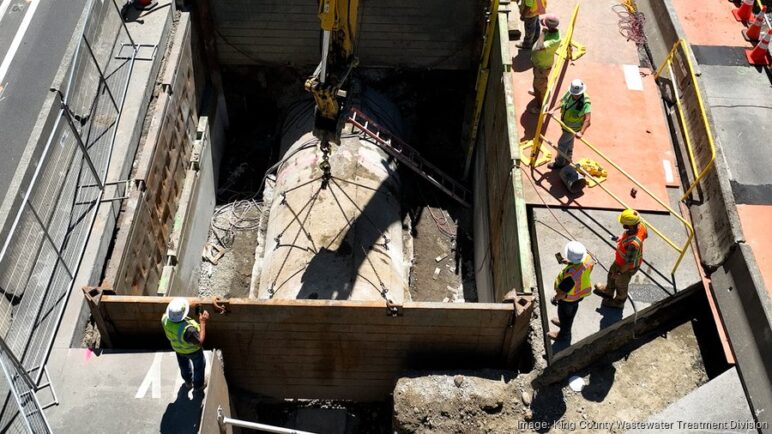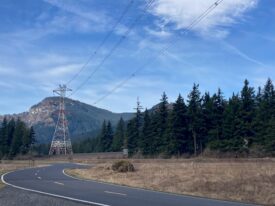The possibility of connecting your home or business to a clean heating and cooling network could be coming to your neighborhood soon.
Washington lawmakers have opened up a new realm of climate-friendly business opportunities for the state’s energy utilities. With the unanimous passage of House Bill 2131, introduced by Representative Alex Ramel (D-40), electric and gas utilities may now sell thermal energy, delivered via a thermal energy network (TEN); gas utilities can win grants for the first TENs pilots; and neighborhood-wide decarbonization with TENs can take off. (Note: this policy is not to be confused with geothermal energy, which the state will also be exploring thanks to Senate Bill 6039.)
“The innovation proposed in this bill is to work with gas utilities—companies that already install pipe, manage rights of way, distribute energy to buildings, and work under the regulatory authority of the UTC,” said Rep. Ramel. “The skill sets and talents of those trained workforces can have an important role to play in decarbonizing our building energy system.”
In line with Washington’s 2023 Biennial Energy Report, which recommended that natural gas utilities plan for the long-term transition to clean heat, this new law will smooth the way for transitioning buildings across the state off of fossil fuels and onto highly efficient, zero-carbon, thermal energy networks. Washington is now the fifth state to pass legislation to allow or mandate that utilities pilot thermal energy networks, and it’s the first to remove legal barriers for neighborhood-wide decarbonization.
Thermal energy networks use a network of water pipes and ground-source heat pumps to transfer heat in and out of buildings to provide heating, cooling, and often, domestic hot water. Buildings on the network can exchange heat with a number of hyper-local, non-combusting, non-emitting energy sources—whatever is available nearby. Sources could include lakes and rivers, energy-intensive buildings like data centers, wastewater systems, or the stable temperature of the ground just a few yards down. And these networks can be designed for any size and can scale up over time, starting as small as two buildings sharing thermal energy and growing to full community-sized or regional-sized systems.

Figure 1: Water circulates through a shared network of pipes to deliver thermal energy to heat pumps in connected buildings. Source: Building Decarbonization Coalition
Thermal energy networks are a win for the climate, electric grids, pipeline workers, and Washington families
A recent US Department of Energy study examined the electric grid impacts of various decarbonization approaches and found that decarbonizing with ground-source heat pumps was the best electric grid cost reduction strategy, reducing transmission line expansion requirements by over a third and generation requirements by 13 percent.
Thermal energy networks can solve some thorny challenges of the clean energy transition: electric grid expansion, gas pipeline workforce redeployment, and equitable access to clean energy. Which helps explain why some unusual bedfellows—building and construction unions, environmental nonprofits, gas utilities, and grassroots activists—all advocated for advancing this policy in Olympia this year.
One of the most striking benefits of TENs is their modest impact on the electric grid due to their ultra-high efficiency. Washington already faces a formidable challenge in trying to build enough electric transmission and generation to power its clean energy transition. A recent US Department of Energy study examined the electric grid impacts of various decarbonization approaches and found that decarbonizing with ground-source heat pumps was the best electric grid cost reduction strategy, reducing transmission line expansion requirements by over a third and generation requirements by 13 percent. An earlier study examined the impact to electricity demand of various building electrification scenarios for space conditioning and found that TENs using ground-source heat pumps were the best option for minimizing demand on the electric grid.

Figure 2: US monthly total electricity demand by sector and projected changes to total building energy demand under different building electrification scenarios. Solid area represents the 2010-2022 demand on the US electric grid from buildings. Dashed lines (labeled by Sightline) represent the projected electricity demand from buildings if fossil fuel end-uses are replaced by four different electrification approaches: electric resistance heat, air-source heat pumps, ground-source heat pumps, and TENs using ground-source heat pumps. Source: Buonocore, J.J., Salimifard, P., Magavi, Z. et al. Inefficient Building Electrification Will Require Massive Buildout of Renewable Energy and Seasonal Energy Storage. Sci Rep 12, 11931 (2022).
Gas workers and their labor unions have been worried about how electrification efforts could eliminate their high-quality, living-wage jobs. Yet TENs offer a pathway for these workers to redeploy with little or no retraining, applying the same skills and expertise used for gas pipelines to the water pipes that carry clean thermal energy. With utilities now able to enter this business, utility workers can even be assured of career continuity with the same employer. That’s why labor unions across the state, including the UA Plumbers and Pipefitters union, which represents gas pipeline workers, logged their support for this bill.
Thermal energy networks also offer communities equitable access to clean heating and cooling. This technology can be scaled up over time to transition entire communities, block by block, to clean thermal energy. Since these shared networks pass by every building on the block, neighbors of all income levels, including renters, can tap into the system, much the same way the gas pipeline system has been available to communities over the past century. But unlike a gas pipeline, a TEN pipeline supplies not just space heat in the cold winters but also air conditioning for the increasingly hot summers, without any additional equipment.
Pilot and grant program advantages gas utilities
Washington’s House Bill 2131 opens the door for any energy utility, electric or gas, public or private, to sell thermal energy. Gas utilities however, with their steep decarbonization mandates and skilled pipeline workforce, may be in the strongest position to pursue thermal energy networks.
To support the initial thermal energy network projects, the bill authorizes the Department of Commerce to administer a $25 million grant program for the state’s six gas utilities. Thanks to this investment, TENs pilots will be prioritized for communities suffering from high air pollution levels and other health disparities, and for areas that could allow for decommissioning gas pipelines or forgo replacing aging pipes. Gas utilities will have until spring 2025 to propose a TEN pilot project, with the expectation that the first projects will go live by the end of 2026.
Already, a handful of utilities in other states have proposed thermal energy network pilots, with the first projects underway in two Massachusetts communities. Encompassing a few dozen buildings, these Boston-area, gas utility-led TEN projects are using networked geothermal to provide heating and cooling to existing buildings. The Massachusetts pilots have prioritized technology and program design research and gas demand reduction.
At least one utility in Washington, Avista, has considered a thermal energy network pilot. The project, which would have connected 25 homes and a community center in an eastern Washington community that uses electric resistance heat, was proposed for a Department of Energy Improvement in Rural or Remote Areas grant in 2023, although the grant application was ultimately unsuccessful.
Up until this year’s passage of HB 2131, Avista could not have owned and led these types of projects itself. Instead, the utility would have been a bystander in the construction, operations, and ownership of the TEN, hoping to learn by watching others implement the project. Now, Avista can take a more active position in these types of projects.
Thermal energy networks enable neighborhood-wide decarbonization with gas pipeline decommissioning
In Washington, as in the rest of the United States, utilities do not have the option of picking their customers. If a customer desires utility service and is willing to pay the published rates, the utility must furnish that service, even if it is costly or inconvenient. This policy, called “obligation to serve,” is one of the daunting barriers to managing the costs of our energy transition. If just one household on the block refuses to drop its gas connection, the utility is unable to decommission the segment of pipe and wipe out the costs associated with operating and maintaining it.
Thanks to Washington’s new law, though, the first of its kind in the United States, the state’s gas utilities can now install a thermal energy network and meet their obligation to serve with this climate-friendly alternative to gas. This update to the “obligation to serve” statute could save gas ratepayers hundreds of millions of dollars as Washington’s gas utilities contemplate how to address hundreds of miles of aging gas pipelines. Long-lived assets like new gas pipelines, which have service lives of 55 years or more, will need to be retired before 2050 to meet Washington’s net-zero carbon emission targets, likely wasting millions of dollars. Instead, gas utilities could make a TEN available in lieu of replacing an aging gas pipe and give customers along the network ready access to clean thermal energy that can realize its entire service life.
The path ahead
Lawmakers have passed a powerful package of reforms for utilities to tackle building decarbonization. To reap the potential, though, utilities will have to start building out new business plans to transform into thermal utilities. Other states’ utilities have already broken ground on these innovations and so can offer lessons to their Washington counterparts.
Which leaves a new question for residents of the Evergreen State: how soon will they see the gas company’s sales reps out knocking on doors to sign up customers for their first thermal energy network?










Jerry Whie
Thank you Sightline for backing this bill. Next is the geothermal.
It bothers me my local paper – The Spokesman Review – doesn’t cover real important new like this.
Lee B. James
I found this article very interesting for its non-technology content. Geothermal has been around for many years. It has sort of moved ahead. Now, with all the cooperative agreements coming into play, I hope it will pick up steam (pardon this throwback expression from the glory days of the fossil fuel era).